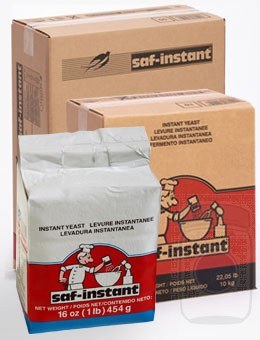
Yeast in Bread—Baking a Doorstop
The Role of Yeast in Bread Making
Yeast is a living organism. Most of the items we put in our refrigerator or freezer are already dead and we are just trying to slow down the decaying process. Yeast is alive (or at least it should be), and so we are going to look at the important the role of yeast in bread.
If you have ever produced a hard brick bearing the name “homemade bread” you know the heartache of wasted time, energy, and ingredients. There could be other reasons for bread that could break glass but the most common is impotent yeast. To have favorable results for bread baking, the yeast used in bread must be viable—so how can you tell if the yeast is good?
Three Steps to Proofing Your Yeast
1. Proper Storage
Your first step is to check the expiration date. If this is not easily visible, find the date of manufacture. Unopened packages of yeast are good for two full years from the date of manufacture. Store the unopened package in a cool, dark, and dry place. The best way to purchase your yeast is in a vacuum-sealed bag, the kind that looks similar to a brick of coffee. This is because air, sunlight, and moisture are the mortal enemies of yeast. So once you’ve opened your brick of yeast, you will need to place the remaining yeast in an airtight, resealable container. Then freeze or refrigerate. You will get a few months more out of it if you choose to freeze it. You can then remove it and use it immediately from your freezer, although I recommend allowing it to warm to room temperature first. Remember, yeast will not be active without first being warm.
2. Yeast Must Be Warm
Next, I urge you to “proof” your yeast, though many modern bloggers and recipes will say that it’s an unnecessary or outdated step. Proofing is too easy to justify skipping this step, and it is not worth the 10 minutes it saved if something happens to be wrong with your yeast—thus yielding a brick. If you are a sale shopper or buy yeast from the grocery store shelf, you could be taking a chance. People do not bake like they used to and the yeast on that shelf has been there longer than you might imagine. Expiration dates are not the whole story, and the function of the yeast in bread will be diminished if the yeast is not viable.
Here is my time tested, fail safe method for testing yeast: pour the warm water that is called for in your recipe into your baking bowl. Make sure that your water is very warm, but not too hot. I test mine on my wrist (like a baby’s bottle) but if you are not sure what temperature to go for, pull out the thermometer the first few times. It ought to be between 110-115˚F. If the water is too hot it will kill off the yeast and if it is too cold the yeast will not activate.
3. Feeding Your Yeast
Lastly, pour in the amount of yeast called for in your recipe. Yeast feeds on sugars, so feed your yeast to proof it. I follow the yeast with my oil and honey. I do the oil first because I won’t waste honey in my measuring cup—the oil will ensure all of the honey pours out nicely. Let this sit for at least 10 minutes (although longer is fine). You will see foam action and bubbling with active yeast. If you do not see that bubbling action, stop now and try different yeast. Don’t waste all of those ingredients on something that will only produce a doorstop.
Otherwise, continue on with the other steps in your recipe as written. These three steps will confirm the viability of your yeast. The role of yeast in bread making is an important one, without it we will only yield door stops.
Here is an alternative method: A friend tells me that even though she bakes with honey for her sweetener, she adds just a tablespoon of sugar to the water and yeast to help stimulate it but does not do it my way because the oil may inhibit the yeast. My bread does get a good rise and I am happy with my method however, I experimented with it her way and did see a major difference during the proofing process! The end result is largely similar, so overall I did not see that much of an impact. You might want to try the experiment.
If phytic acid is a concern for you, add a few cups of your flour (not so much to make dough yet) and let your mixture proof for awhile longer—this soaking period will reduce the phytic acid in your bread.
There is so much to learn in successfully baking a loaf of bread, I hope that you have learned more about what the yeast in bread does for your end result. Truth is that there are thousands of recipes for bread (I have my own favorite), but learning why yeast in bread is so important makes the beginner’s path to nice bread shorter. Leave a comment, tell us about your bread baking learning curve!
Chaya
If you are new to bread baking altogether, you can get an exclusive offer to receive a free how-to video from us on bread baking by signing up for our email list (you will find that at the bottom of our homepage). Rest assured, we do not load up your inbox with spam.

